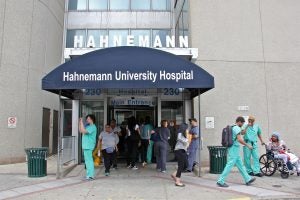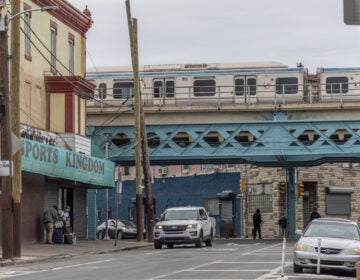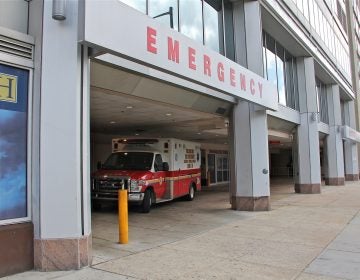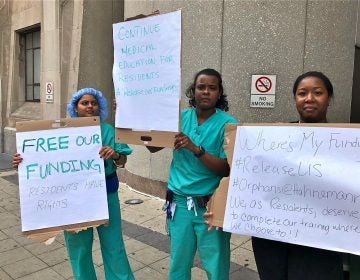Hahnemann’s closure will leave medical residents scrambling
Shifting government funding between hospitals and sticking to visa requirements are some challenges facing medical residents as they seek new placements.
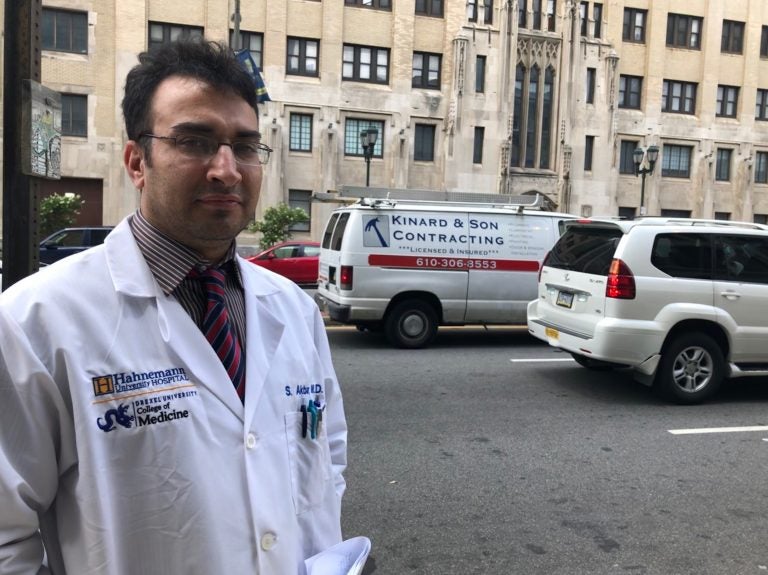
Siddique Akbar, a second-year nephrology fellow at Hahnemann, is concerned about uprooting his family if he has to find a new placement out of town. (Nina Feldman/WHYY)
Siddique Akbar found out his hospital was closing the same way most people did: on the news. It came as a shock. A second-year nephrology fellow at Hahnemann University Hospital, he had settled in Philadelphia with his wife and three kids, who are all in school and love it here.
Akbar did his residency in London and went to medical school in Pakistan, where he was born. He’s counting on his program director to find a new placement for him in Philadelphia. He has a lease on his house, and his salary supports his whole family.
“I’m trying to play it cool,” he said, talking about his family between rounds at the hospital. “I’m just telling them it will work out. If they know all the information I’m having, definitely they would have more concern.”
Leadership at Hahnemann, the main teaching hospital for Drexel University’s College of Medicine, announced last week that the 495-bed facility would close. The hospital began winding down emergency services over the weekend, and a temporary manager is now in place there, representing the Pennsylvania Health Department, to ensure Hahnemann closes in a responsible way.
The closure will mean Hahnemann’s 570 doctors-in-training need to find new placements. After a stressful residency match process and establishing roots in a new community, the prospect of picking up and starting all over again is undoubtedly stressful for them all. But for doctors like Akbhar, the implications are even more serious.
About 55 of the medical residents at Hahnemann are international. Their J-1 cultural exchange visas require active contracts with a hospital, so if they can’t find new placements within 30 days of losing their jobs at Hahnemann, they’ll have to leave the country.
These doctors are licensed and vetted through a 60-year-old nongovernmental organization, the Educational Commission for Foreign Medical Graduates (ECFMG), which is the sole entity authorized by the U.S State Department to sponsor the visas for the international physicians.
Of the more than 1 million licensed practicing physicians in the United States, one-quarter went to medical school outside the U.S. and Canada. Recent research predicts that the United States could see a shortage of more than 120,000 doctors in the next 15 years, as demand continues to grow faster than supply. Some international trainees see their residency placements as an entree to immigrate to the United States, while many others return to their home countries with their training.
“From the trainee’s perspective, they still see the U.S. as the primo place for medical education,” said William Pinsky, the president of ECFMG.
Akbar said he’d hoped to stay in the U.S. to continue his studies because the medical education here was far better than in the U.K. Now, he’s not so certain.
About 20,000 people apply through the ECFMG each year, with roughly 12,000 making it into the match program. About half of those are placed at American institutions. The medical licensing and background-vetting process is rigorous and usually takes about three years, according to Pinsky. He’s worried that if word gets out these residents had to leave the country, fewer will try to come in the future.
“In terms of how difficult it is to get through the process, it means we have the best of the best that are coming here,” Pinsky said. “Frankly, this is a disaster.”
International medical graduates most often end up as practicing physicians in internal and family medicine. Studies have shown they practice in hospitals with greater numbers of high-needs patients and primary-care shortages.
At Hahnemann, 16 of the international graduates began their first year of residency July 1.
“This couldn’t be at a worse time since all the programs around the country are just starting the brand new year and are busy orienting their new residents,” Pinsky said.
His organization will offer financial help to Hahnemann residents who need to relocate and is asking the State Department for leniency if they can’t be placed again before their 30 days are up, he said.
Teaching hospitals around Philadelphia expressed their support for Hahnemann’s residents, international and otherwise, at the news of its closing.
“We will certainly work to accommodate those residents in concert with the appropriate regulatory and oversight bodies,” said Ruth Lefton, president and chief operating officer for Einstein Medical Center Philadelphia and its affiliated campuses.
Jefferson Health and Cooper Health both have already set up websites where displaced residents and fellows can apply.
But any hospital might hesitate to hire new residents without being certain their funding would follow.
Residents and fellows are funded through the Center for Medicaid and Medicare Services (CMS). Their money travels with them as they change placements. Typically, when a resident shifts placement as the result of a closure, that resident has to be employed by a new institution on the day his or her prior hospital closes.
“Can they look for a job right now? Yes,” said Janis M. Orlowski, chief health-care officer with the Association of American Medical Colleges. “Can they line things up? Yes. Can they make the transition today? No.”
Orlowski said her organization is in ongoing conversations with CMS to understand how the rules actually apply in a situation like this. She said that though hospital teaching programs close and smaller teaching hospitals shutter, an orphaning of medical residents on this scale is unique.
“Hopefully, it will be orderly, but it’s a little chaotic right now,” she said.
Hahnemann has yet to release its trainees’ funding, which has left a lot of residents frustrated. Jo Linnen, a third-year anesthesiology resident, was outside the hospital Wednesday, demanding that management release the residents’ funding so they can look for other jobs. She said multiple programs in Philadelphia and elsewhere along the East Coast have expressed willingness to take her.
“They understand what’s going on, but they have these concerns about where’s our funding,” Linnen said. “The patient load here is minuscule compared to what’s going on in the other city hospitals that have more cases for us to train from. It is a disservice to us to keep us here.”
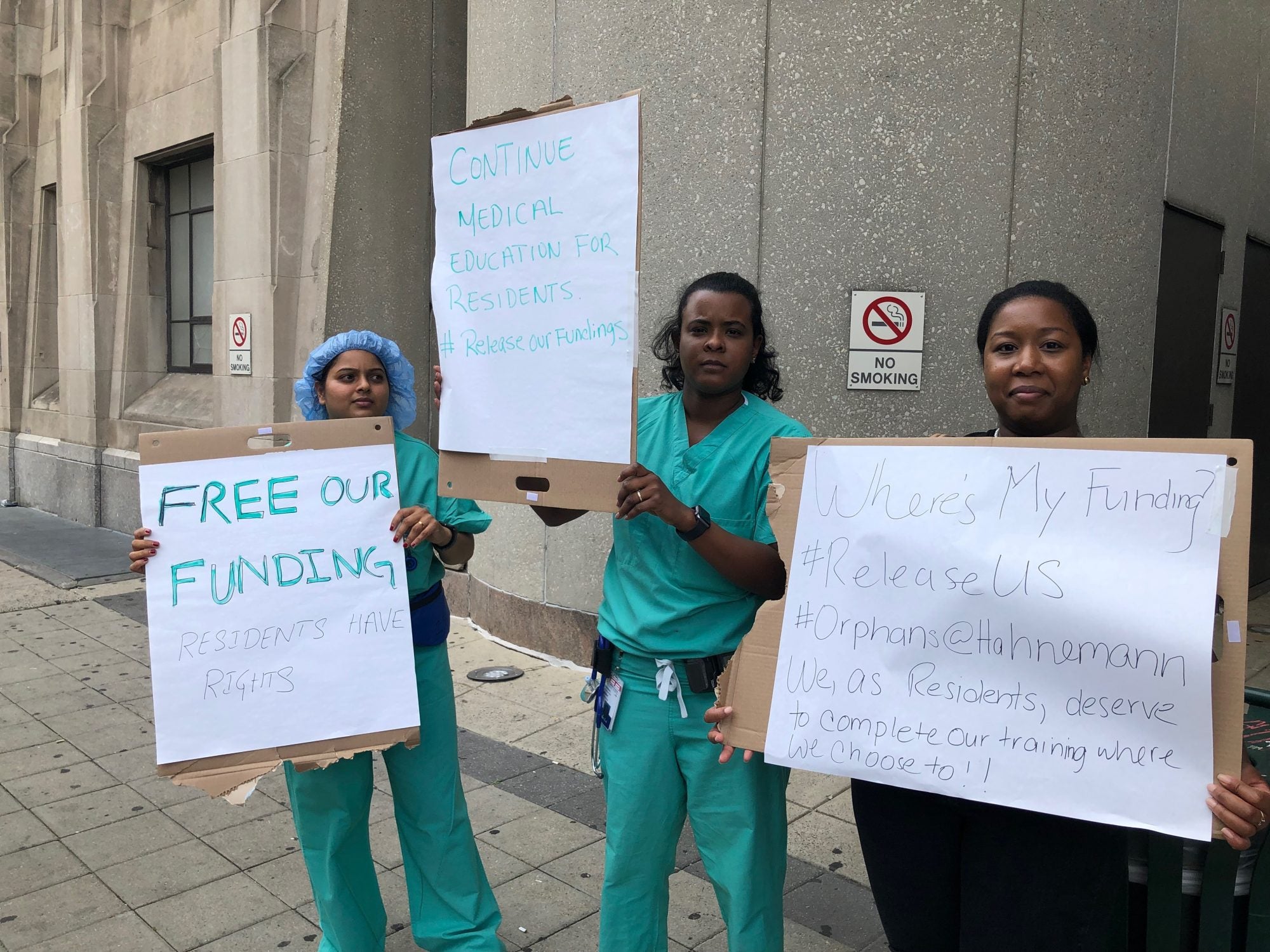
As of Wednesday, there were fewer than 100 patients at Hahnemann.
Linnen’s program director in the anesthesiology department, Shelley George, said she has requested that her residents’ funding be released by Hahnemann’s leadership — without any luck.
Both Linnen and Akbar said they hoped to remain in Philadelphia.
“We’re used to working in Philadelphia — we know the demographics, the patients here,” said Akbar. “Going to a new place, it will be like starting fellowship from the beginning.”
WHYY is your source for fact-based, in-depth journalism and information. As a nonprofit organization, we rely on financial support from readers like you. Please give today.


